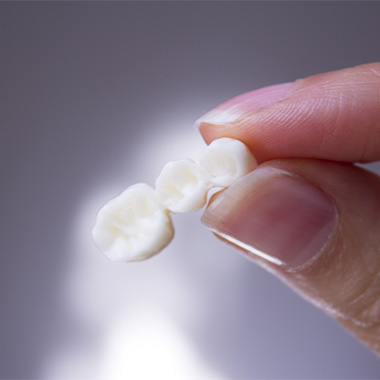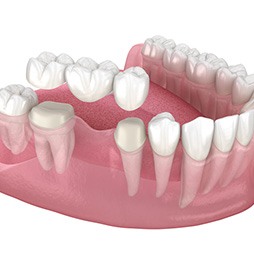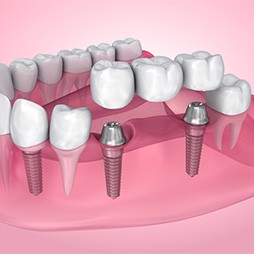Dental Bridges – Winchendon, MA
Replace the Teeth That You’re Missing
Tooth loss can be absolutely devastating. Missing your front teeth can seriously impair your ability to project the confidence that you’d like, and losing a molar will make it difficult to eat all the things that you’d like to.
Dental bridges are an easy and effective method of replacing the teeth that you’re missing, providing a realistic and stable bite. Make an appointment with the team here at Unique Dental of Winchendon and we’ll tell you what we can do for your smile.
Why Choose Unique Dental Of Winchendon For Dental Bridges?
- Restorations Made From High-Quality Materials
- An Experienced Dentist to Attend to your Needs
- Dental Team With Your Needs In Mind
What is a Dental Bridge?

A dental bridge is a fixed dental restoration used to replace one or more missing teeth by joining an artificial tooth permanently to adjacent teeth or dental implants. It typically consists of two or more crowns and pontics in between. They’re best suited to helping patients who are missing 1-4 consecutive teeth. Dental bridges help restore the function and appearance of teeth, maintain facial structure, and prevent remaining teeth from shifting out of position.
Types of Dental Bridges

There are two kinds of dental bridges out there, and which you should use depends on what you’re looking for from your procedure. We’ll be able to tell you more at your consultation, but here’s some information about each in the meantime.
Traditional Dental Bridges

Traditional dental bridges are secured to the natural teeth for security, much like dental crowns. This provides your new teeth with a strong bite without the need for surgery. This also tends to be the more inexpensive variety of dental bridge.
Implant Bridges

Implant bridges, as the name would imply, are attached to metal posts that are surgically implanted into the jaw. This affords them incredible strength and durability, meaning that patients are often able to save money on replacements in the long run.
The Benefits of Getting a Dental Bridge

Dental bridges offer several benefits, the ability to chew and speak properly. They help maintain the shape of your face by preventing the sunken appearance that can occur with missing teeth. Bridges also distribute the forces in your bite properly by replacing missing teeth, preventing remaining teeth from drifting out of position.
Additionally, they can improve oral health by reducing the risk of gum disease and tooth decay that can arise from gaps in your teeth. Overall, dental bridges provide functional and aesthetic improvements, enhancing both confidence and dental health; if you’re interested in learning more, don’t hesitate to make an appointment with us today!
Dental Bridges FAQs
Can You Take a Dental Bridge Out?
No, you should not attempt to remove a dental bridge on your own. Dental bridges are cemented in place and require a dentist’s expertise and special tools for safe removal. Trying to remove it yourself can damage the bridge, your teeth, and surrounding tissues. If you're experiencing discomfort or issues with your dental bridge, schedule an appointment with us. We can assess the problem and provide the appropriate solution, ensuring your oral health is maintained.
Is Getting a Dental Bridge Painful?
Getting a dental bridge is generally not painful. The procedure involves preparing the abutment teeth, which may require local anesthesia to ensure you’re comfortable. You might experience some sensitivity or discomfort after the procedure, particularly in the gums and the prepared teeth, but this typically subsides within a few days. Over-the-counter pain relievers can help manage any discomfort. If you experience significant pain or prolonged discomfort, it’s important to contact your dentist, as it could indicate an issue that needs attention.
Is a Partial Denture the Same as a Bridge?
While partial dentures are sometimes called “removable bridges,” they aren’t the same thing. A partial denture is a removable appliance that replaces multiple missing teeth and is supported by the remaining natural teeth and gums. It can be taken out for cleaning and is generally more affordable.
A dental bridge, on the other hand, is a fixed prosthetic device that replaces one or more missing teeth by anchoring to adjacent teeth or dental implants. It is permanently cemented in place and offers more stability and a natural appearance compared to partial dentures.
How Many Teeth Can a Dental Bridge Replace?
A dental bridge can replace one to four missing teeth in a row, depending on the specific case and the strength of the abutment teeth or implants supporting the bridge. Replacing more than four teeth with a single bridge can compromise its stability and effectiveness. For larger gaps or multiple missing teeth in different areas, a combination of dental bridges, implants, or partial dentures might be better for you. Whether your a good candidate for a bridge depends on factors like the the size of the gap in your smile, the stability of the surrounding teeth, and the your overall oral health.
